
Occult rock is a dark, vintage-leaning strain of hard and psychedelic rock that centers on esoteric, witchcraft, and ceremonial themes. It pairs heavy, riff-led songwriting with theatrical vocals and ritualistic imagery—candles, robes, sigils—evoking a sense of mystery and forbidden knowledge.
Musically it draws on late-1960s/early-1970s hard rock and acid-drenched psychedelia: overdriven guitars, warm tube tones, analog organs (Hammond, Mellotron), fuzz bass, and dry, punchy drums. Songs are typically mid‑tempo, minor‑key, and hooky, favoring modal turns (Aeolian, Phrygian) and occasional tritone or chromatic color to heighten the ominous atmosphere.
Lyrically, it references grimoires, folklore, and occult philosophy, often balancing narrative storytelling with chant-like choruses. Modern revivals preserve the 70s aesthetic—tape-saturated mixes and retro gear—while refining arrangements and production for contemporary audiences.
Occult rock cohered at the end of the 1960s when rock musicians began fusing heavier blues‑rock and acid rock with explicitly esoteric imagery. Coven (USA) and Black Widow (UK) were early standard-bearers, staging ritual‑like performances and writing songs steeped in witchcraft and ceremonial lore. In parallel, Black Sabbath’s bleak tonal language and doom‑laden themes (though not always overtly ritualistic) set an enduring sonic template for heaviness and dread that many occult‑minded bands drew upon.
Through the 1970s, the style occupied a shadowy corner of hard and psychedelic rock: minor‑key riffs, analog organs, and theatrical storytelling. While never a mainstream movement, the aesthetics seeped into contemporaries—from UK and US underground acts to more visible bands that flirted with arcane subject matter. Bootlegs, fanzines, and word‑of‑mouth trading helped sustain its mystique.
As metal splintered into new subgenres, occult rock’s specific blend became less visible, but its themes and harmonic darkness influenced traditional doom and helped seed the ritualistic imagery later embraced by parts of extreme metal and goth‑adjacent scenes. Collectors and reissue labels kept interest alive.
A full revival emerged in the late 2000s and 2010s with bands like The Devil’s Blood, Ghost, Blood Ceremony, Jess and the Ancient Ones, Uncle Acid & the Deadbeats, Witchcraft, and Lucifer. These groups codified the sound: 70s‑styled production, fuzz‑rich riffs, vintage keyboards, and dramaturgical vocals, packaged with meticulously curated occult aesthetics. International scenes—from Scandinavia to North America—created a flourishing network of festivals and boutique labels.
Modern occult rock balances historical fidelity (analog gear, classic songcraft) with contemporary clarity. It remains a niche but vibrant scene that continues to influence doom, stoner, and retro‑minded heavy music, while serving as a conduit for storytelling that blends folklore, ritual, and rock theatre.

